We have a strict honest review policy, but please note that when you buy through our links, we may receive a commission. This is at no extra cost to you.
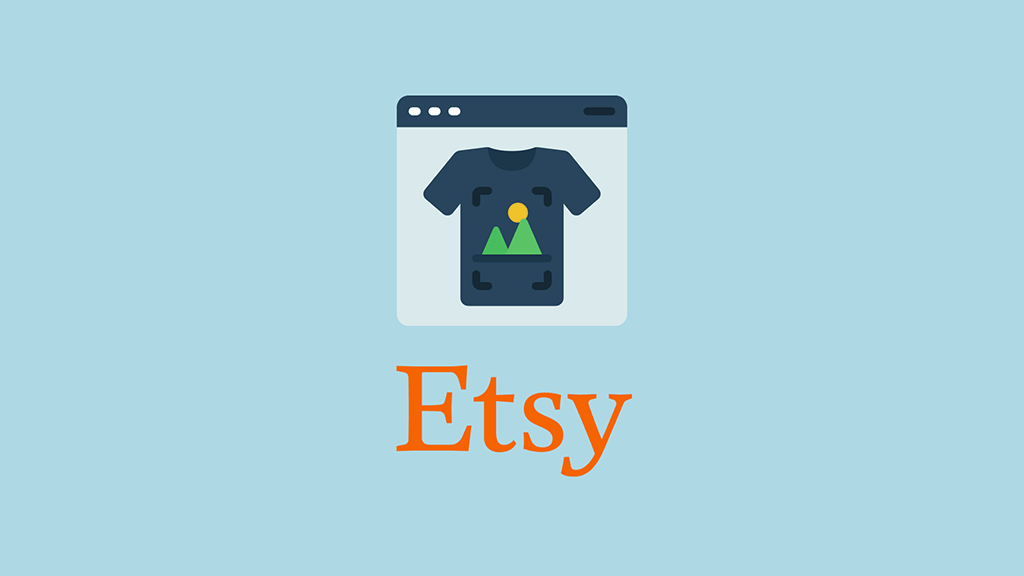
In this simple, step-by-step guide, I’m going to show you how to start a print on demand business on Etsy — and share practical tips on how to make it a successful one.
Tools you’ll need for Etsy print on demand
Let’s start things off with a quick look at why Etsy is a great choice for POD.
Etsy and print on demand — a perfect pairing?
Print on demand (POD) gives you one of the simplest ways to start selling online. You simply upload your designs to a print-on-demand platform, and when someone buys your product, your POD supplier prints, packs and ships the product to your customer automatically.
(This means you can forget about buying stock or running to the post office to fullfil every order!)
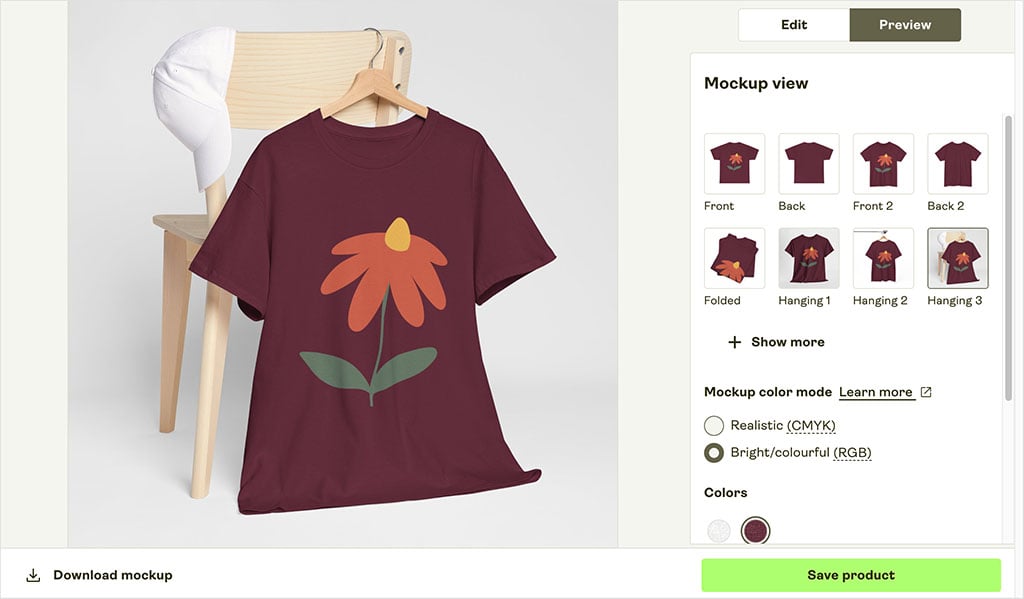
This makes POD a low-risk business model that lets you focus on creativity rather than logistics. It lets you test ideas quickly and try out new designs without large upfront costs — all while building a catalogue that grows with your audience. From t-shirts and hoodies to mugs, tote bags and wall art, there’s a print-on-demand product for almost every niche imaginable.
And Etsy is the perfect home for this type of online business. With around 95 million active buyers browsing the platform in search of distinctive products, Etsy attracts customers who love bespoke, design-led items — exactly the sort of custom products that work well in a print-on-demand store.
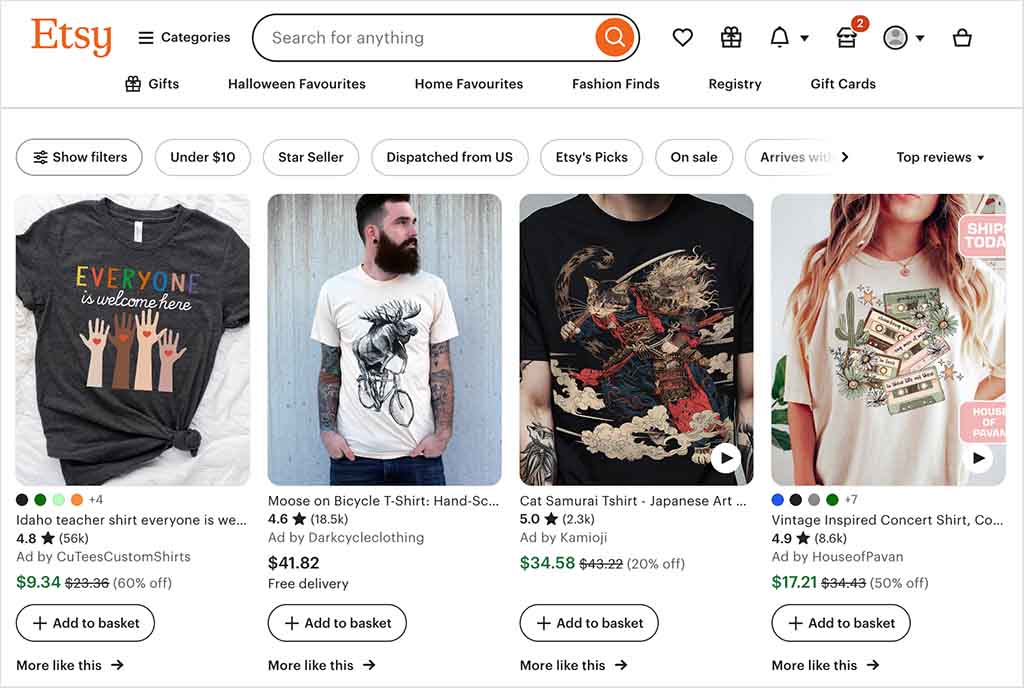
And because Etsy’s fees are modest — a $0.20 listing fee plus a small commission / payment charge on each sale — it’s easy to start small and scale up over time.
But, how do you actually start selling POD products on Etsy?
Well, the first step is to pick a print-on-demand provider. Let’s take a look at how to do that.
1. Choose a print-on-demand provider for your Etsy store
To sell print-on-demand products on Etsy, you’ll need to connect your shop to a fulfillment partner — a company that prints and ships your products whenever an order comes in.
Popular options here include Printify, Printful, Gelato and Gooten. Each of these services integrates directly with Etsy, letting you design products once and have them produced automatically when a customer buys them.
In this tutorial, I’ll be using Printify as the example print-on-demand supplier. It’s one of the most widely used print providers for Etsy sellers, thanks to its huge product catalog of over 1,300 items, competitive pricing and fast global shipping through a large network of print partners.
Printify also performs strongly when it comes to user satisfaction with a Trustpilot rating of 4.6 out of 5 from over 6k reviews — and it consistently earns excellent reviews from Etsy merchants who praise its reliability and ease of use.
And importantly, Printify offers a range of Etsy-specific features, such as product personalization options, automated order syncing and simple mockup tools that make listing designs on Etsy quick and straightforward.
To get your Printify account, just head over to the Printify website and click the ‘Get Started for Free’ button.
You’ll then be taken through a quick onboarding process. When you reach the ‘Where do you plan to sell?’ step, choose Etsy from the list of platforms. (This tells Printify to prepare your account for Etsy integration.)
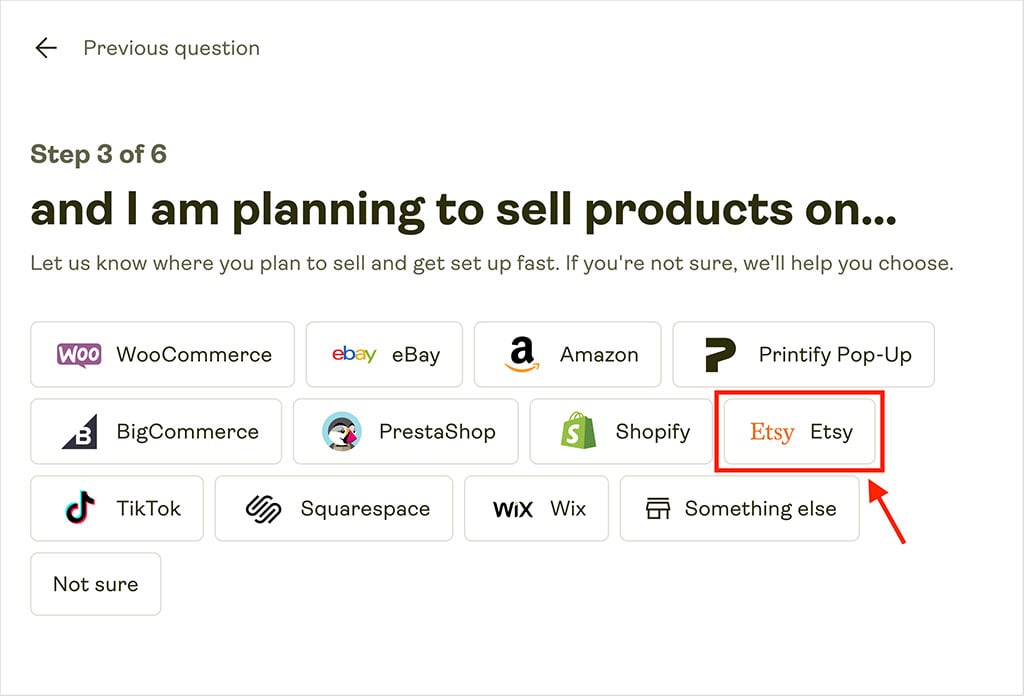
Once you’ve signed up for Printify, you’ll need to connect the platform it to Etsy. But before that you’ll need to make sure you’ve got an Etsy seller account.
So, next up, I’ll take a quick look at how to get one.
2. Create your Etsy seller account
To create an Etsy seller account, go to the Etsy homepage and click ‘Sign in’ at the top-right corner of the page.
You’ll then see a box appear prompting you to log in or register. Click the ‘Register’ button at the top-right corner of this box.
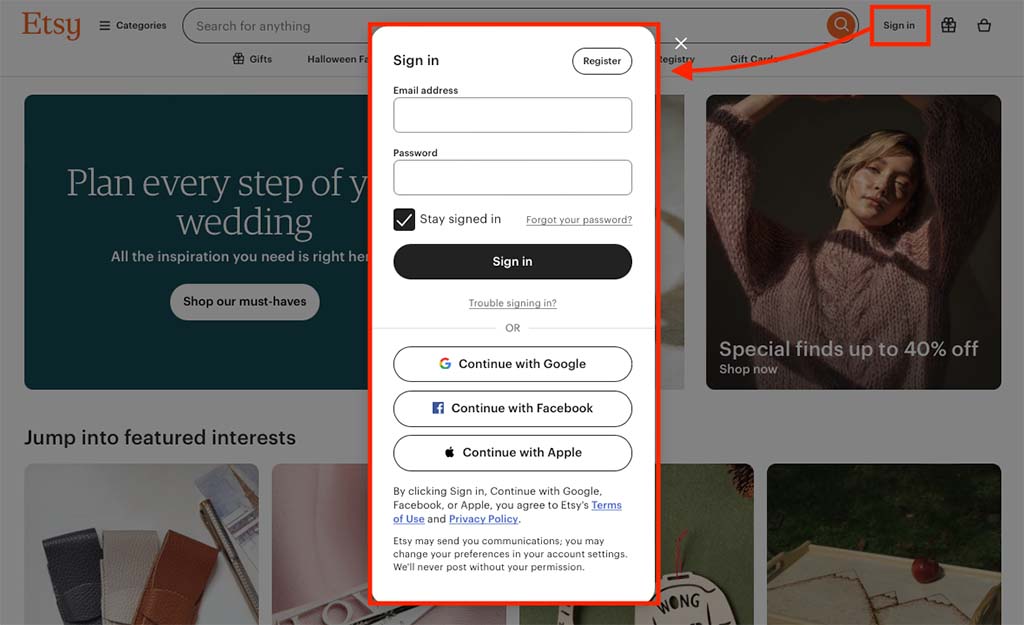
You can then use a Google, Facebook or Apple account to sign up, or register using your email address.
Once you’ve registered, the next step is to open your Etsy store. To do this, click your profile picture at the top of the Etsy interface and then select ‘Sell on Etsy.’
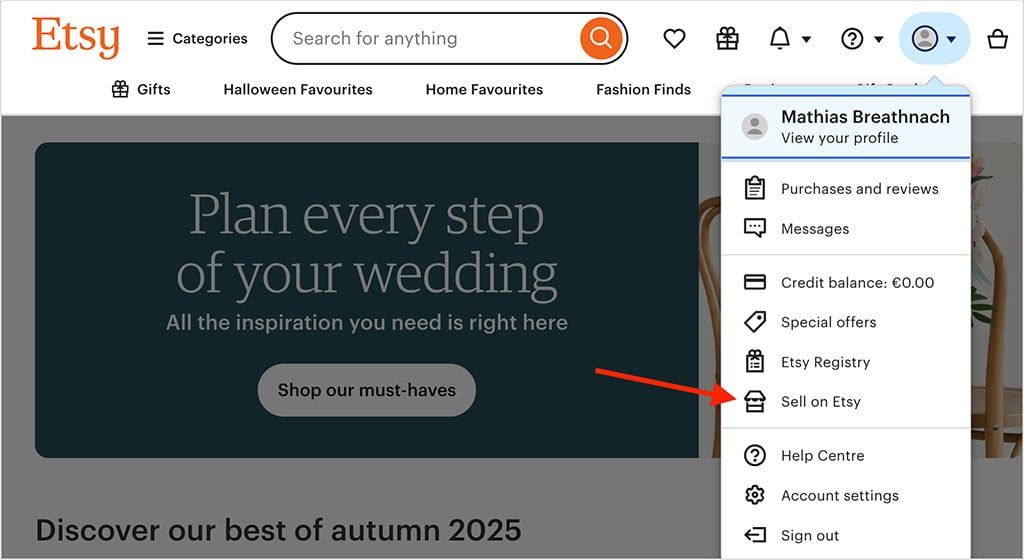
Then click the ‘Get started’ button to launch Etsy’s shop setup wizard. You’ll be guided through a series of steps that cover:
- Shop preferences (choose your default language, country and currency)
- Name your shop (pick a short, memorable name that reflects your brand)
- Add listings (create at least one product — a temporary ‘dummy’ product will do for now)
- How you’ll get paid (enter your bank details so Etsy can send you payments)
- Set up billing (add a credit or debit card for listing and transaction fees)
- Shop security (verify your account and review your shop settings).
When you’re on the Add listings step, add a temporary or dummy product listing to activate your shop. In this listing, scroll down to Production partners and add Printify (Etsy requires you to disclose who manufactures your items).
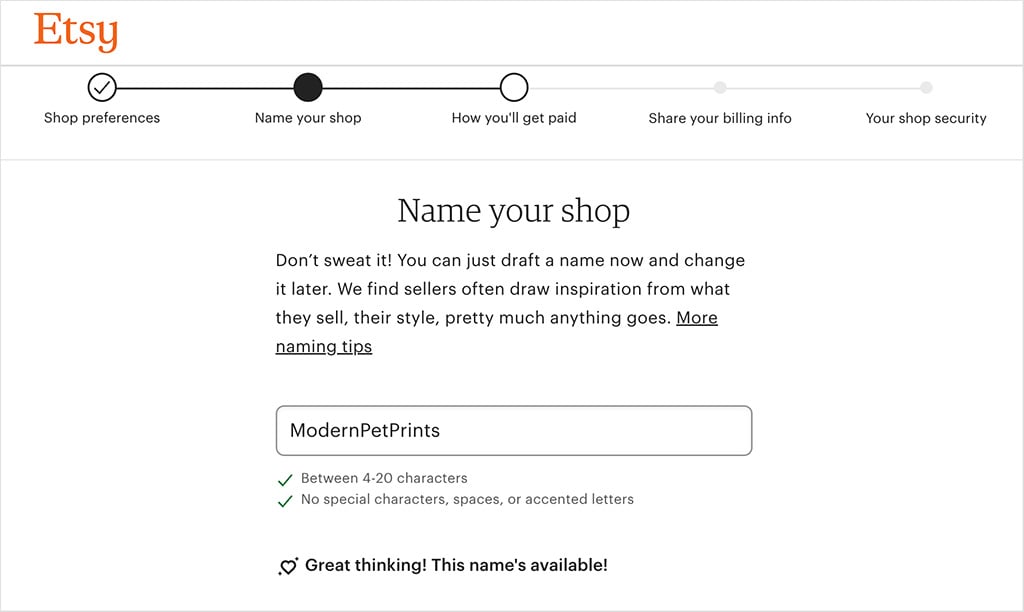
Once your dummy listing is active, you’re ready to move on to connecting Printify to Etsy, and publishing your real products.
3. Connect Printify to Etsy
Now it’s time to connect your Printify and Etsy accounts.
If you selected Etsy during the Printify onboarding process, you’ll see a ‘Connect my store’ button on your dashboard — click this to begin the integration.
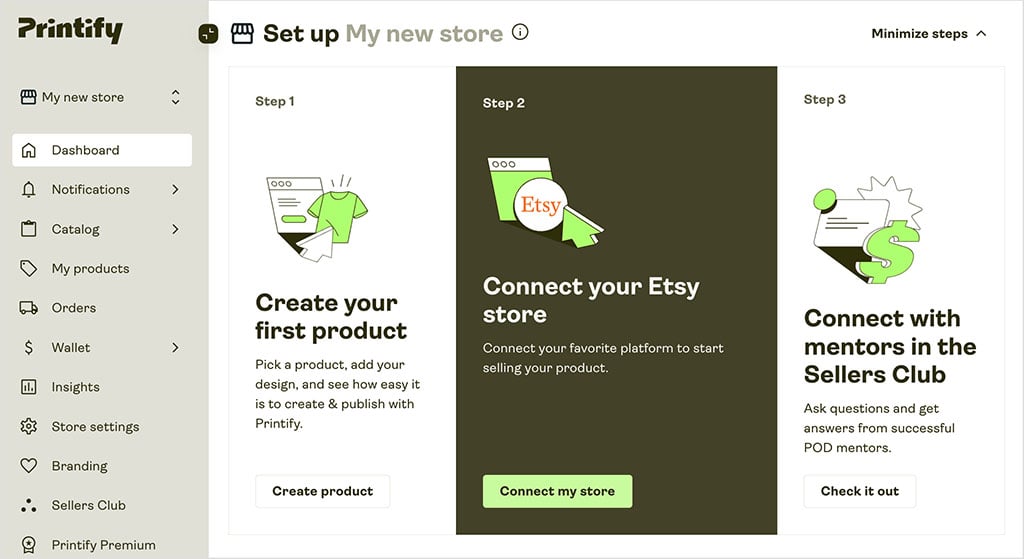
If you skipped that step, don’t worry. You can simply go to ‘My new store’ in your Printify dashboard and choose Etsy from the list of available sales channels.
Either method will open a new Etsy sign-in window. Log into your Etsy account and click the ‘Grant access’ button when prompted — this authorizes Printify to connect to your Etsy shop.

Once access is granted, your Etsy and Printify accounts are officially linked, allowing Printify to automatically publish new product listings to your store and manage fulfillment when your Etsy customers place orders.
Now for the fun part: designing your print on demand products.
4. Design your first product
Now it’s time to create your first product in Printify.
Click the ‘Create your first product’ button on your dashboard, or open the Printify catalog to browse the wide range of items available.
Printify offers hundreds of customizable products — from t-shirts and hoodies to mugs, tote bags, phone cases and posters.
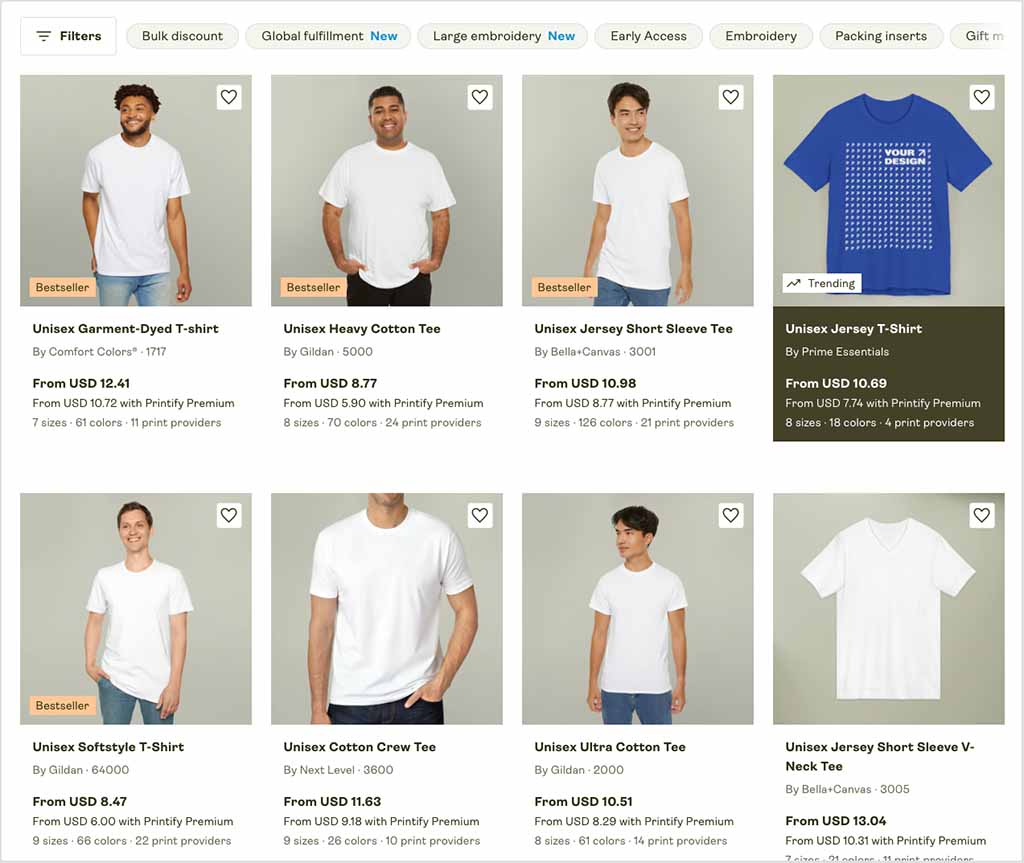
You can even apply the same design to multiple product types, but for now, pick just one to get started. Then, use the Printify product designer to add your artwork.
You can upload a design you’ve already created, or use Printify’s built-in tools to add text, graphics or photos — and even generate AI images if you’d like.
At this stage, you can also choose your product variants, such as color and size options.
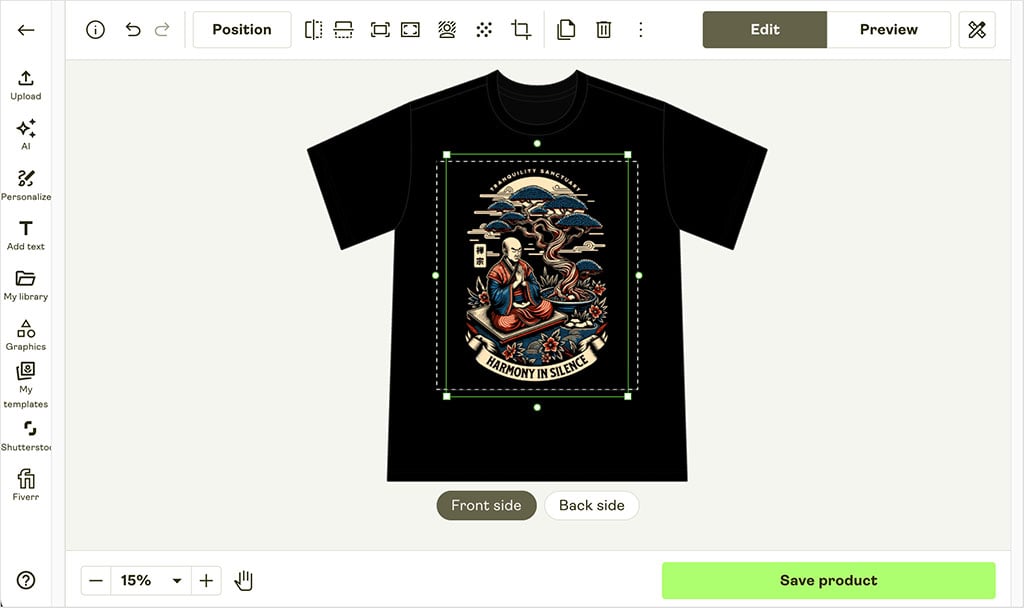
When you’re happy with your design, click ‘Save product.’
Now, your product won’t be live on your Etsy store yet — you’ll need to publish it later. But before you make your product available to customers, it’s worth taking one extra step to be sure everything looks right…
5. Order a sample
Before listing your product on Etsy, I strongly recommend ordering a sample to check that everything looks and feels right.
To do this, go to your Printify account, click the ‘Create order’ button, and then ‘Sample.’ Select the exact product variant (such as size and color) that you want to test, then enter your shipping details and complete the order.
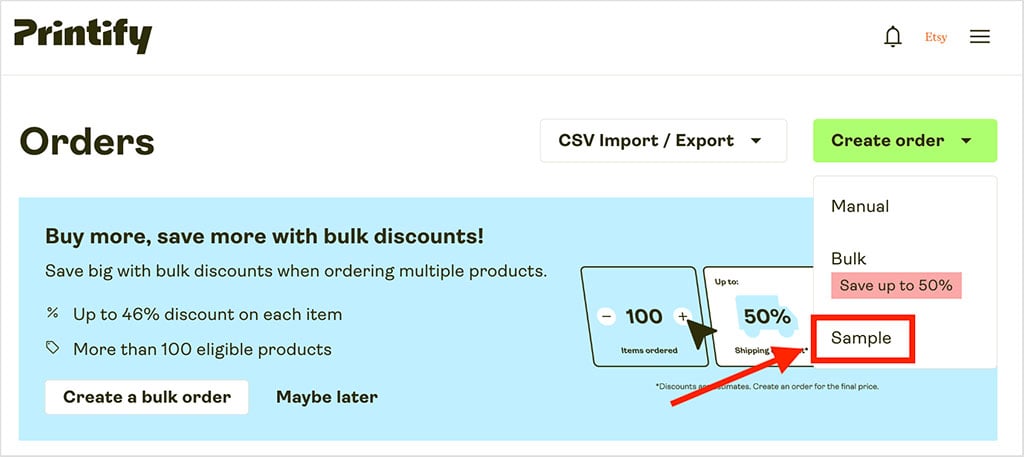
Printify samples usually arrive quite quickly, and checking they meet your expectations is a simple but important step. Taking the time to do this ensures you’re selling high-quality items on Etsy, gives you confidence in your listings and helps you avoid potential customer issues later.
6. Set prices and publish your listing
Before publishing your product on Etsy, it’s important to review and finalize your pricing.
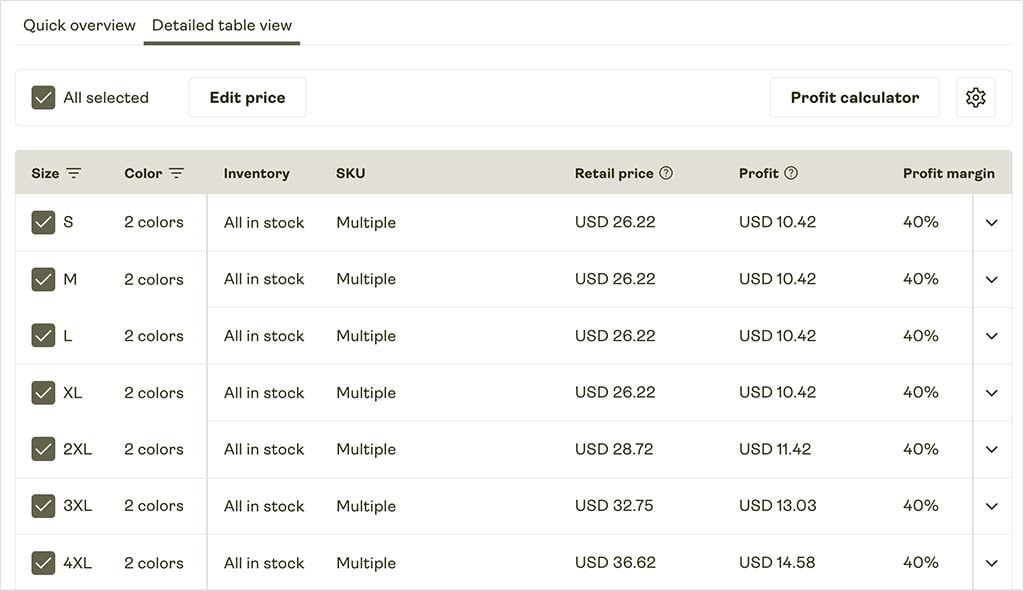
To do this, go to your Printify dashboard, open the ‘My products’ section and select the product you’ve designed. Take a moment to check the base cost of the item and set your retail price accordingly.
Printify provides suggested prices, but you can adjust them to achieve your desired profit margin.
(Remember to factor in Printify’s production charges, Etsy’s listing and transaction fees, and any shipping costs.)
This is also a good time to decide whether to enable product personalization. Printify supports two types for Etsy:
- Manual personalization — where you receive the buyer’s custom text or image request, and manually update the design before sending it to Printify for production.
- Automated personalization — where the customer’s input is automatically placed into your design using Printify’s editor (and you review the final version before fulfillment).
(If you plan to offer personalized products, make sure your mockup images use realistic sample text rather than placeholders like ‘Your Name Here,’ as Etsy doesn’t allow this in listing thumbnails.)
Once you’re happy with your prices and personalization settings, tick the product’s checkbox and click ‘Publish.’
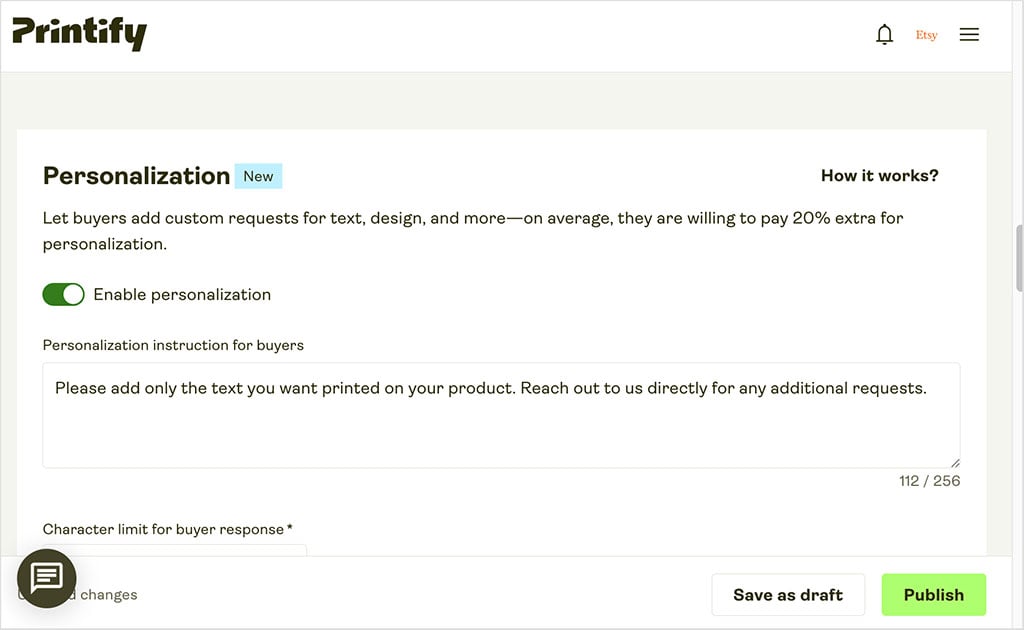
During the publishing process, Printify will ask whether to sync all product details or keep your existing store details. Choosing to sync everything is usually best — it ensures that your titles, descriptions, mockups, colors, sizes, tags and shipping profiles are consistent between Printify and Etsy.
When the publishing process is complete, you’ll see a ‘Product published successfully’ message.
To confirm that everything has synced correctly, open your Etsy Shop Manager and click ‘Listings.’ Your new product — complete with its images, description and price — should now appear, ready for your customers to purchase.
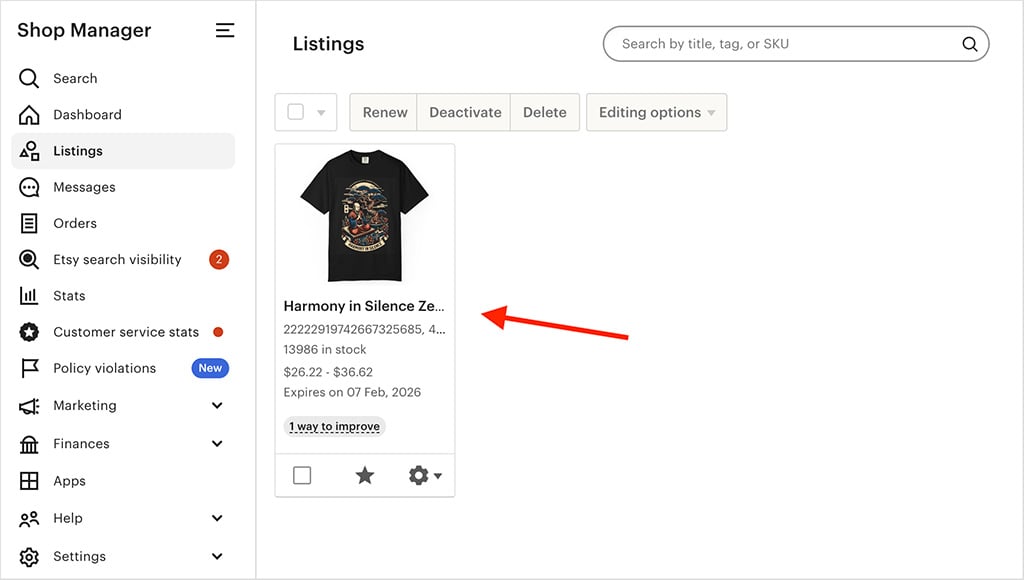
7. Test your sales process
Before you start promoting your Etsy shop, it’s worth running a quick order through it. This makes sure everything is working properly.
For me, the best way to do this is to place an order through your live Etsy listing and following it through the full process —i.e., from Etsy to Printify to fulfillment.
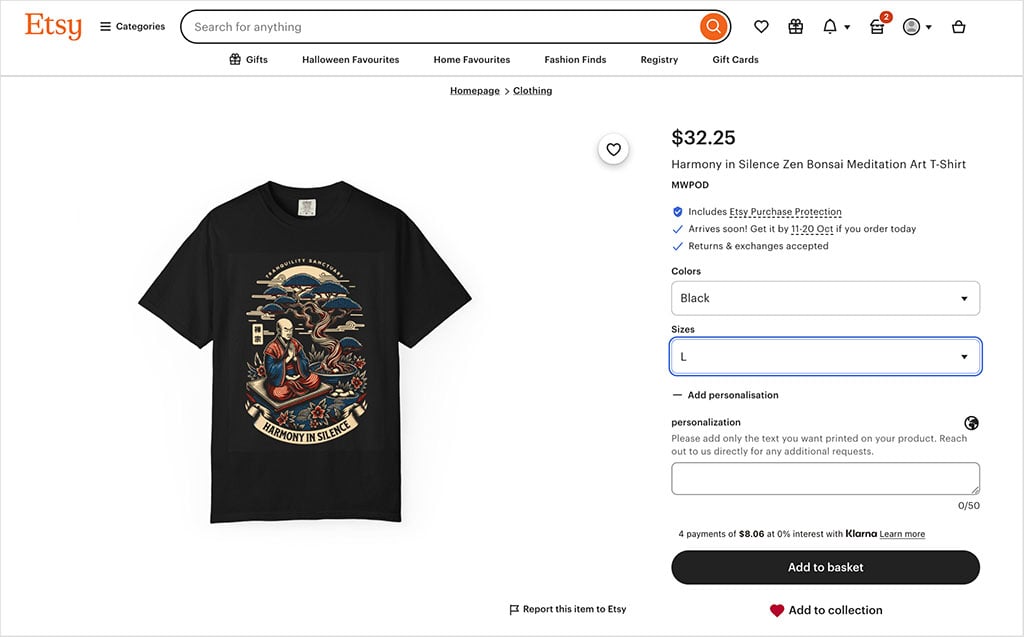
Once the order appears in your Printify dashboard, check that the product details, personalization data (if applicable) and shipping information have all synced correctly.
Once you’ve tested your first product… expand your range
After testing your first product and confirming that the purchase and printing process is running smoothly, it’s time to broaden your catalog. Printify lets you add designs to over 1,300 customizable products, so there’s huge scope to experiment and grow.
In addition to staples like t-shirts, hoodies, mugs and tote bags, Printify’s catalog includes plenty of creative options that suit Etsy’s audience perfectly — you can sell everything from journals, candles and wall art to puzzle sets, aprons, yoga mats, Christmas ornaments and pet accessories.
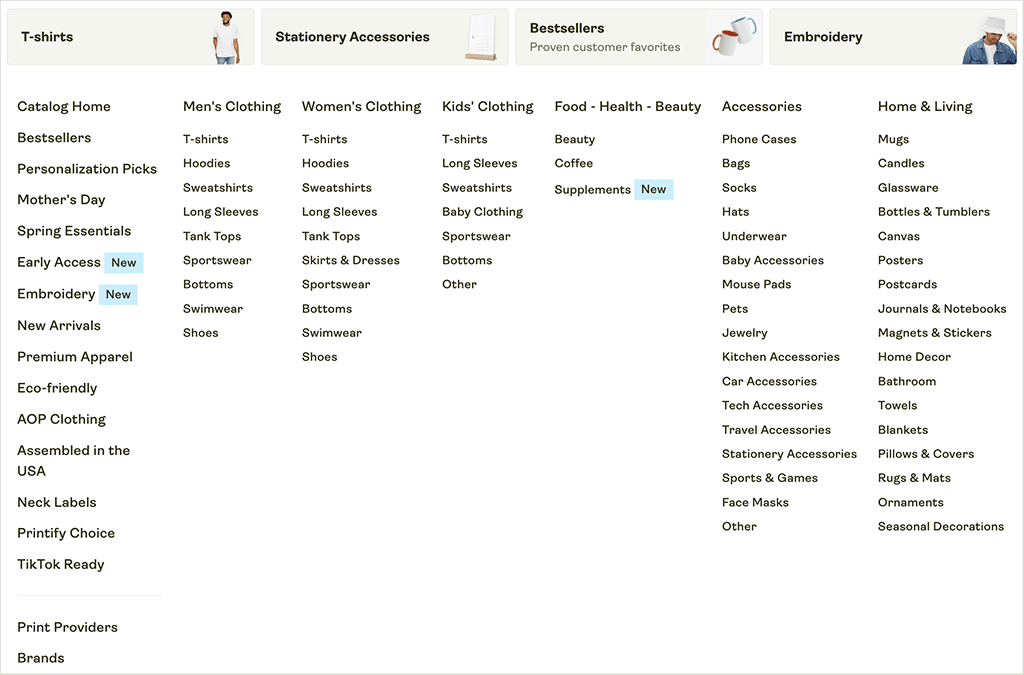
And the beauty of print on demand is that you can try new ideas with almost no risk. Try adding designs that complement your niche or target community — for example, botanical prints for gardeners, funny crafting quotes for makers, or keepsake ornaments for new parents.
The more high quality products you list with a consistent theme, the more opportunities you’ll have to appear in Etsy search results — and the faster your POD business will grow.
8. Promote and grow your Etsy print-on-demand store
Once your Etsy storefront is live, the next step is to attract shoppers and turn them into buyers. Etsy is a competitive marketplace, but with smart optimization and consistent marketing efforts, your print-on-demand product listing can stand out and generate sales.
Here are a few tips on how to promote your product range:
✔️ Define your niche
One of the best ways to succeed on Etsy is to carve out a clear niche. Stores that focus on a specific type of buyer — for example, book lovers, new parents, crafters, gardeners, or fans of vintage-inspired design — usually perform much better than general ‘print shop’ stores.
Focusing on a niche target market also makes it easier to build long-term, loyal customers, and generate repeat business.
✔️ Optimize for Etsy SEO
When building your audience, it’s important to focus on Etsy SEO — the process of improving your listings so they appear higher in Etsy search results and attract more Etsy shoppers.
To do this, you’ll need to add relevant keywords to your product titles, product descriptions and Etsy tags, using the same phrases your target customers are likely to search for (for example, ‘funny coffee mug,’ ‘custom pet portrait,’ or ‘minimalist wall print’ etc.).
Etsy’s built-in Search Analytics tool shows which terms are driving traffic to your listings, but it’s worth going further. Third-party tools like eRank and Marmalead help you identify trending Etsy search phrases, while tools like Semrush are very useful for identifying phrases that people searching for products on Google typically use.
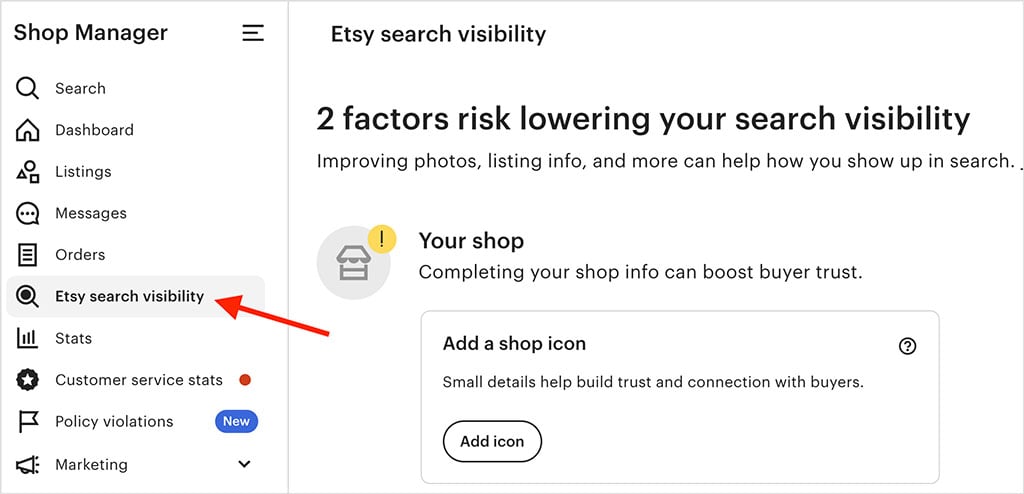
When naming your Etsy shop, aim for something that’s both memorable and SEO-friendly — ideally one that includes a keyword related to your niche (for example, ‘ModernPetPrints’ or ‘PositiveTeeStudio’).
✔️ Use great imagery
Strong product imagery is one of the biggest factors in Etsy success. Printify provides mockups for every product, but you can also consider using a platform like Placeit for a much wider range of realistic, lifestyle-style mockups (available for a small fee).
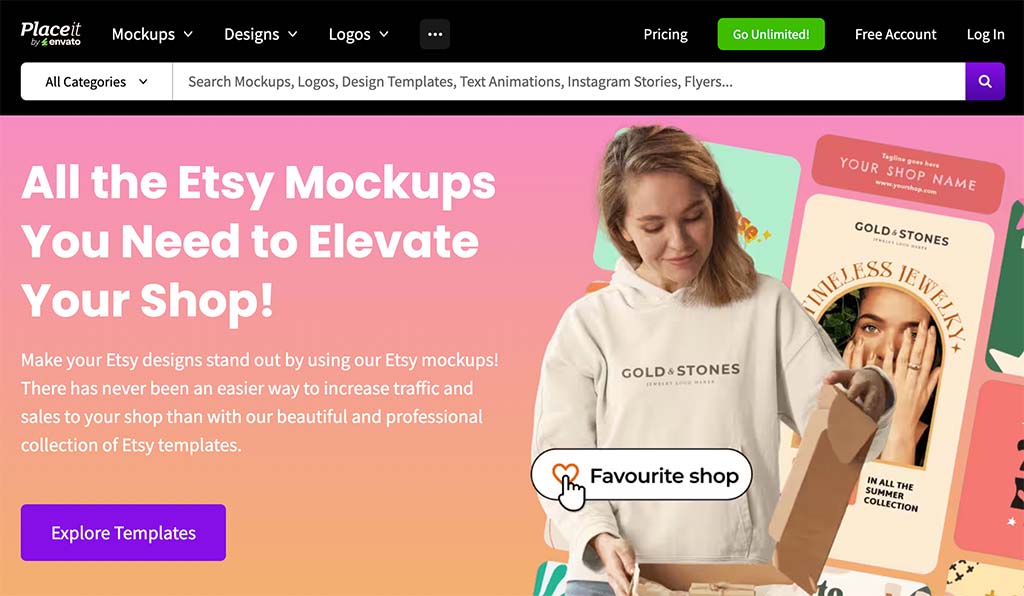
✔️ Use social media and Etsy ads to showcase your POD products
Once your listings look their best, start promoting them outside of Etsy. Visual platforms like Pinterest, Instagram and TikTok are ideal for doing this.
Post photos or short videos that showcase your products in context — think mugs on kitchen counters, prints on living room walls, t-shirts being worn etc. — and include your Etsy shop link in each piece of content you produce.
You could also experiment with Etsy Ads, which promote your listings directly in Etsy search results. Start with a small daily budget and focus on your best-performing products to learn what drives the most clicks and conversions.
✔️ Encourage reviews and repeat business
Positive reviews can make a big difference to your visibility in Etsy search. Encourage them!
To get good reviews, it’s important to respond quickly to messages; keep buyers updated about orders and resolve any issues politely. Including a short thank-you note in your packaging is another simple way to build loyalty and encourage repeat purchases.
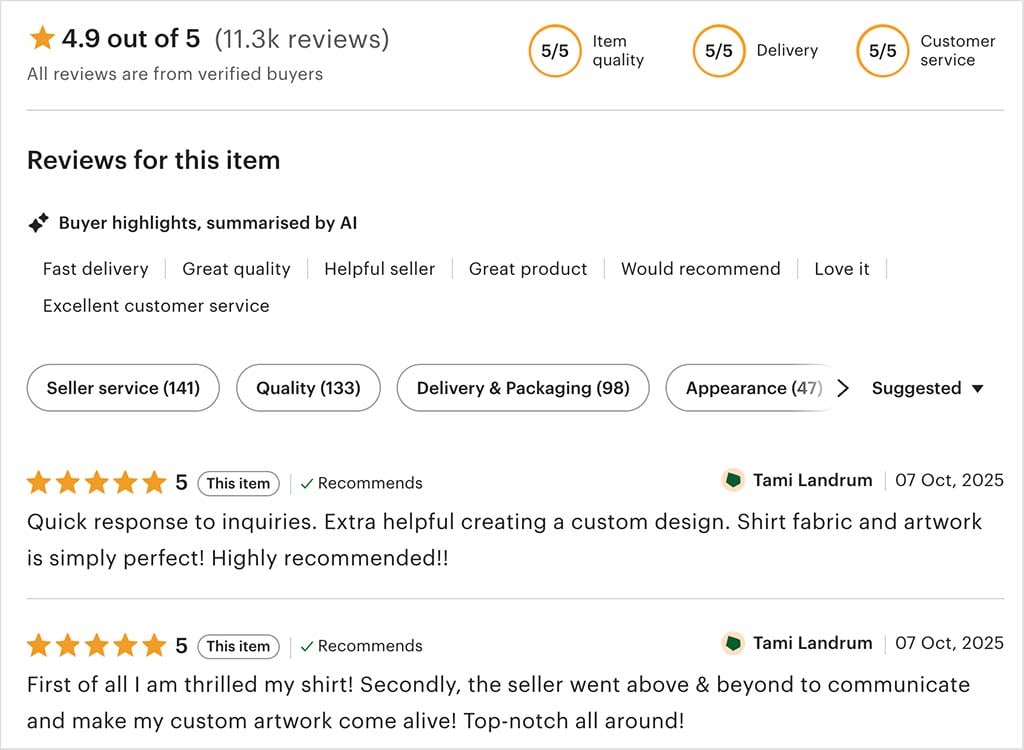
✔️ Do email marketing for your Etsy POD store
While Etsy doesn’t allow you to automatically add customers to an email list, you can invite them to join one voluntarily. Adding a QR code or link to your packaging that leads to a sign-up page for updates or exclusive offers is fully compliant with Etsy’s terms. Tools like Omnisend or GetResponse make it easy to share news about new collections or seasonal discounts with customers who’ve opted in.
✔️ Keep refining and adapting
Finally, treat your Etsy POD shop as a work in progress.
Check your analytics regularly to see which listings are performing best — and refresh underpeforming ones with new mockups, keywords, or descriptions. Plan ahead for seasonal events like Valentine’s Day, Mother’s Day or Christmas — and design new products around trending themes.
With high-quality imagery, thoughtful keywords and consistent customer service and promotion, a Printify-powered Etsy store can become a reliable and rewarding creative business — one that grows steadily as your brand and catalog expand.
Good luck creating your print-on-demand business with Etsy — and if you have any questions about setting one up, just leave them in the comments section below.
Etsy Print on demand FAQ
Is Etsy print on demand profitable?
It can be — many Etsy sellers earn solid profits with print on demand, especially when they focus on high-quality designs and a clear, profitable niche. Because Printify handles production and fulfillment, your upfront costs are minimal, making it a low-risk way to build an online business.
What’s the difference between Etsy print on demand and dropshipping?
Both models eliminate the need for holding inventory, but print on demand is centered on custom designs. With the POD business model, each item — like a t-shirt, mug, or art print — is produced only after an order is placed. Dropshipping, by contrast, typically involves selling pre-made products from a supplier’s existing catalog.
How do I connect Etsy to Printify?
To connect Etsy to Printify, first add a store in your Printify dashboard and select Etsy as your sales channel. You’ll then be prompted to log into your Etsy account and grant Printify access. Once the connection is confirmed, your Etsy shop will appear in your Printify account — and any products you create in Printify can be synced or published directly to your Etsy store.
Do I need to make my Etsy shop live before using Printify?
Yes. Etsy requires you to have an active shop with at least one listing before you can connect it to Printify. You can create a simple ‘dummy’ listing to activate your store — it doesn’t have to be a final product — and replace it later once your Printify connection is complete.
What are the best products to sell with Etsy print on demand?
T-shirts, hoodies, mugs, tote bags and art prints are perennial Etsy favorites. But Etsy buyers also love creative or sentimental items — such as custom ornaments, journals, pet accessories and wall decor. Printify offers more than 1,300 customizable products, giving you plenty of room to experiment and discover what sells best in your niche.
Can I use more than one print on demand service with Etsy?
Yes. Etsy allows you to work with multiple print-on-demand partners at the same time. Many sellers use Printify as their main provider while testing others — such as Printful, Gelato, or Gooten — for specific product types or regional fulfillment. Just make sure you accurately list each provider as a production partner in your Etsy listings to stay compliant with Etsy’s seller policies.
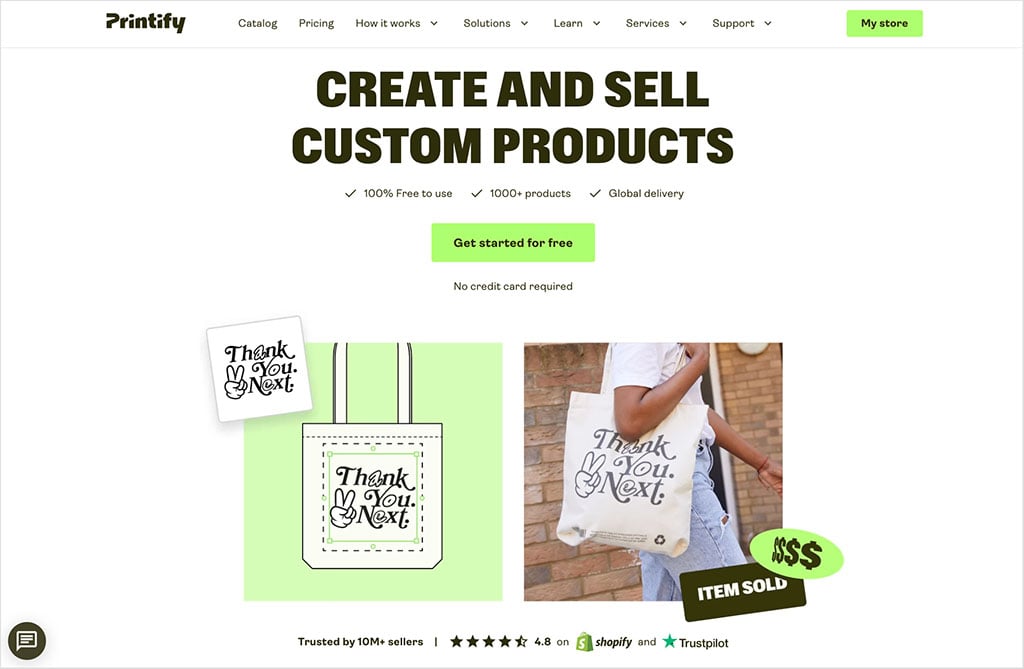
No comments